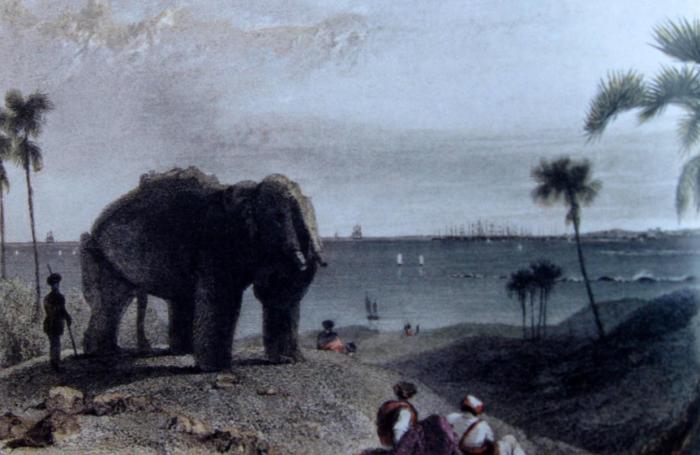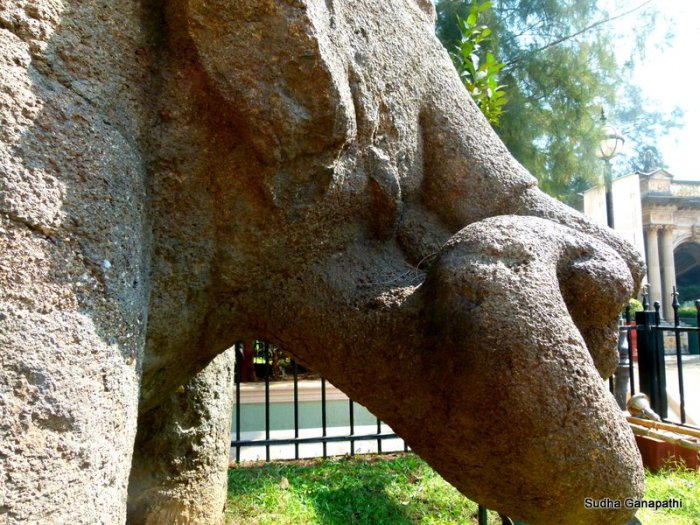 In a fenced enclosure outside the Dr. Bhau Daji Lad Mumbai City Museum (formerly known as Victoria & Albert Museum) at the Jijamata Udyaan (formerly known as Victoria Garden) in Mumbai, is an Elephant. Not a flesh and blood elephant, mind you, but a stone elephant with a long and interesting history to share.
In a fenced enclosure outside the Dr. Bhau Daji Lad Mumbai City Museum (formerly known as Victoria & Albert Museum) at the Jijamata Udyaan (formerly known as Victoria Garden) in Mumbai, is an Elephant. Not a flesh and blood elephant, mind you, but a stone elephant with a long and interesting history to share.
Carved in the 6th century from a single piece of rock at one of the many entrances to the island known as Gharpuri, the Elephant saw many a king come and go for over a 1000 years. Then one day, in early 16th century, the Elephant saw the first European colonisers — the Portuguese — to the region. The Portuguese were so awed by him that they promptly named the Gharpuri after him — the Elephanta Island, a name it has been known as since then.
When the Portuguese relinquished their rights over the region to the British 150 years later, the Elephant was witness to this as well. The new colonisers were also impressed and awed with him. In fact, the English were so impressed with the Elephant, that they wanted to take him home to England. But this was no easy task and it took them nearly 200 years to put their wish in action.
On a sunny day in 1864, a crane was brought to the Island to lift the Elephant from his rocky home and transport him to ship that would then take him to a new home at a museum in England. This was no easy task and the local people and the English Officers directing this operation watched with bated breath as the crane huffed and puffed, and finally managed to lift the Elephant.
And as the arm of the crane swung around with its elephantine cargo, disaster struck. The crane snapped sending the Elephant crashing down and breaking him into pieces.
The broken fragments were collected and brought to Sir George Birdwood, the curator of the Victoria & Albert Museum of Bombay. Under his supervision, the pieces were joined back, and this is what it looks like today.

The plaque reads:
This stone elephant stood at the entrance of Rajabunder Jetty to Gharpuri or Elephanta Island. The Elephant symbolised royalty for the Rajabunder Jetty was used exclusively by the local Rajas…. The Island derived its European name “Elephanta” from the Portuguese. In 1864, the British attempted to carry the Elephant back to England. The crane, however, broke and the Elephant shattered into several pieces. The fragments were brought to Victoria Garden (Veermata Jijabai Bhosale Udyan) and were reintegrated by Sir George Birdwood, the curator of the erstwhile Victoria & Albert (Dr. Bhau Daji Lad) Museum
See the picture below. One can still see cracks and places the Elephant was joined together. In fact, one can even see mortar in some places.
 It is difficult to estimate how tall the Elephant was before he broke into pieces, but take a look at what he looked like in his original environment.
It is difficult to estimate how tall the Elephant was before he broke into pieces, but take a look at what he looked like in his original environment.

The Elephant must have been carved by the same people who sculpted the beautiful Elephanta Caves. Just take a look at the photographs—he looks just raring to go ! The photo below captures the fluid movement of the Elephant’s trunk so well. Broken, joined or whole, he is a majestic sight.
 Times have changed today.
Times have changed today.
The Elephant has come a long way from the days of seeing kings and royal visitors walk past him with admiring glances to awestruck European colonisers coveting him. These days, visitors to the Udyaan and the zoo within or even the Museum outside which the Elephant is fenced in walk past him without a second glance. For the few who do notice him, it is only to place him as a backdrop for a photograph. The significance of the Elephant and his history have long been forgotten or overlooked as many do not know that he is the Elephant that gave the world-famous Elephanta Caves Island its name.
The Elephant is an example of the many things we ignore, overlook and forget with time. But remember the old saying that elephants never forget. And this post is a gentle reminder to not forget or ignore or overlook things around us.
PS: Fellow Mumbaikars, do take a little time off and visit the Elephant. He’ll appreciate it. 🙂

I remember this story from the Amar Chitra Katha on Elephanta and from a 4th grade history lesson. All those years in Mumbai and I have never gone to Elephanta. I will have to rectify that on my next trip, maybe drag you along with me to talk about it. That would be one memorable experience. Also, love your header picture. I’m assuming it’s from the trip to Rajasthan
LikeLike
Don’t worry, it took me 23 years to visit the Elephanta Caves, where I heard the this story. And I met the Elephant only about 3 months back ! And when are you coming to Mumbai? I would love to visit Elephants again 🙂
Thank you. The header is of the Kumbhalgarh Fort on a full moon night and a view that made me want to never leave the place again 🙂
LikeLike
You are a treasure house :):) Will take R there over a weekend when her school closes 🙂 thank you
LikeLike
Thanks, RM. You can perhaps club it with the zoo and the gardens and when it gets too hot, escape to the air-conditioned museum 🙂
LikeLike
You brought back old memories of Rani baug… Thanks for posting.
LikeLike
Welcome here Sunith and thank you so much for stopping by and commenting. Glad you liked the post and the memories that came with it. 🙂
LikeLike
Loved this post! I love elephants, and have always been meaning to visit the Elephanta Caves, so naturally, this post was darn interesting for me. 🙂 As RM says, you are indeed a treasure house. 🙂
I will ensure that I visit this place whenever I am in Mumbai. Shall we add this place to the ever-growing list that I am maintaining, of places to see with you? 🙂
It is so sad to read of one country wanting to take away the art of another country, resulting in so much damage in the process. 😦
LikeLike
Taking away priceless art or destroying it has always been a practice of all victors and colonisers. You have to visit the British Museum in London to see just how much the English have “collected” from their colonies. 😦
I’m also maintaining a list of places to take you around in Mumbai and at the rate it is growing, you might consider coming for a longer trip 🙂
LikeLike
Thanks to you,….Elephanta caves is definitely gonna figure in my agenda now, when I visit Mumbai next :-)…
LikeLike
Hey Spirit. Welcome here and thank you so much for stopping by and commenting. Do visit the Elephanta Caves as it is more than worth it. And if you have the time, do also visit Jijamata Udyaan, to meet this Elephant.
LikeLike
6th Century? That’s a grand old elephant. Nice to know it’s been living a long life despite all the damage. (They wanted take away this monolithic elephant too?!)
LikeLike
Oh yes. He is one grand old Elephant and looks very life like up close. when I saw the trunk, I almost thought it would move to touch me 🙂
Oh yes, the Brits wanted to take the Elephant. I’m thankful that they did not break the sculpted panels in the caves to take it back to England 😦
LikeLike
Sudhagee which fort is that on the header image?
LikeLike
It is the Kumbhalgarh Fort on a full moon’s night 🙂
LikeLike
Lovely! Something new for me
LikeLike
Thanks, Raghav. 🙂
LikeLike
very interesting… will certainly visit.
LikeLike
Welcome here Delhizen and thank you so much for stopping by and commenting. Glad you found it interesting. And enjoy your visit 🙂
LikeLike
Love your header very much .
LikeLike
Thank you very much, Team G Square. It is a picture of the Kumbhalgarh Fort taken about a fortnight ago on full moon’s night 🙂
LikeLike
Haan! Sudha! It is such a pity that our own artistic history is ignored till the west acknowledges it. I too have put up a relatively recent post – unexpected from me, I know 🙂 – about some less known sculptures in tamil nadu – Indian Scuplture – The Samavediswara Temple – which I am honored to be able to visit and learn about periodically thanks to a group in Chennai.
LikeLike
Appreciation of our art is also considered by many as snobbery. Until of coure, the West shows its appreciation 🙂
A 10-day holiday to Rajasthan and I am lagging behind reading posts on all my favourite blogs. Looking forward to reading about the Samavedishwara Temple.
LikeLike
Nice post! Thanks for sharing this.
http://www.rajniranjandas.blogspot.in
LikeLike
Thank you. And welcome 🙂
LikeLike
That was a very interesting mail. Thanks. Now I know why the caves off Mumbai are so named! Ashraf
LikeLike
Thanks, Ashraf. Glad you enjoyed reading it 🙂
LikeLike
Reblogged this on Rachnasoni's Blog.
LikeLike